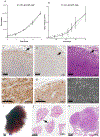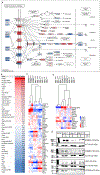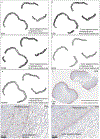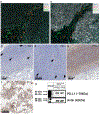A Syngeneic ErbB2 Mammary Cancer Model for Preclinical Immunotherapy Trials
- PMID: 30810966
- PMCID: PMC6612594
- DOI: 10.1007/s10911-019-09425-3
A Syngeneic ErbB2 Mammary Cancer Model for Preclinical Immunotherapy Trials
Abstract
In order to develop a practical model of breast cancer, with in vitro and syngeneic, immune-intact, in vivo growth capacity, we established a primary cell line derived from a mammary carcinoma in the transgenic FVB/N-Tg(MMTV-ErbB2*)NDL2-5Mul mouse, referred to as "NDLUCD". The cell line is adapted to standard cell culture and can be transplanted into syngeneic FVB/N mice. The line maintains a stable phenotype over multiple in vitro passages and rounds of in vivo transplantation. NDLUCD tumors in FVB/N mice exhibit high expression of ErbB2 and ErbB3 and signaling molecules downstream of ErbB2. The syngeneic transplant tumors elicit an immune reaction in the adjacent stroma, detected and characterized using histology, immunophenotyping, and gene expression. NDLUCD cells also express PD-L1 in vivo and in vitro, and in vivo transplants are reactive to anti-immune checkpoint therapy with responses conducive to immunotherapy studies. This new NDLUCD cell line model is a practical alternative to the more commonly used 4T1 cells, and our previously described FVB/N-Tg(MMTV-PyVT)634Mul derived Met-1fvb2 and FVB/NTg(MMTV-PyVTY315F/Y322F) derived DB-7fvb2 cell lines. The NDLUCD cells have, so far, remained genetically and phenotypically stable over many generations, with consistent and reproducible results in immune intact preclinical cohorts.
Keywords: Breast cancer; Erbb2; Immunotherapy; Mouse model; PD-L1; Syngeneic.
Conflict of interest statement
CONFLICT OF INTEREST:
The authors declare that they have no conflict of interest.
Figures






References
-
- Zitvogel L, Pitt JM, Daillere R, Smyth MJ, Kroemer G: Mouse models in oncoimmunology. Nature reviews Cancer 2016, 16(12):759–773. - PubMed
-
- Aslakson CJ, Miller FR: Selective events in the metastatic process defined by analysis of the sequential dissemination of subpopulations of a mouse mammary tumor. Cancer research 1992, 52(6):1399–1405. - PubMed
-
- Mosely SI, Prime JE, Sainson RC, Koopmann JO, Wang DY, Greenawalt DM, Ahdesmaki MJ, Leyland R, Mullins S, Pacelli L et al.: Rational Selection of Syngeneic Preclinical Tumor Models for Immunotherapeutic Drug Discovery. Cancer immunology research 2017, 5(1):29–41. - PubMed
Publication types
MeSH terms
Substances
Grants and funding
LinkOut - more resources
Full Text Sources
Medical
Molecular Biology Databases
Research Materials
Miscellaneous

